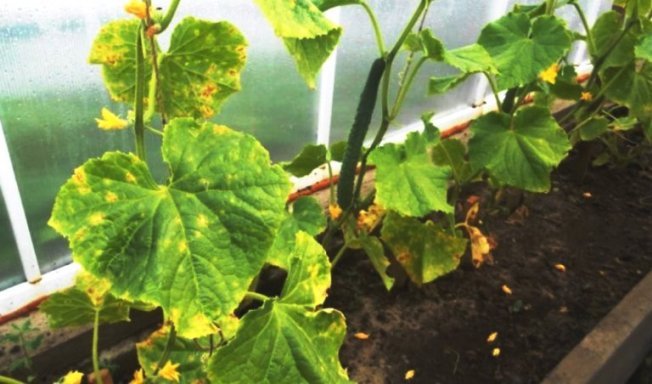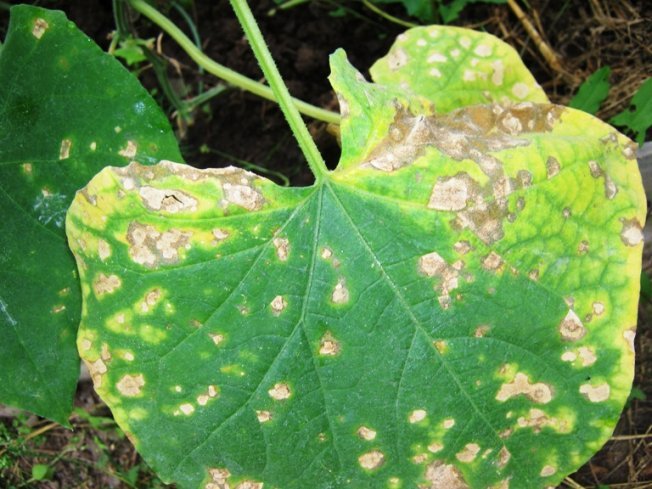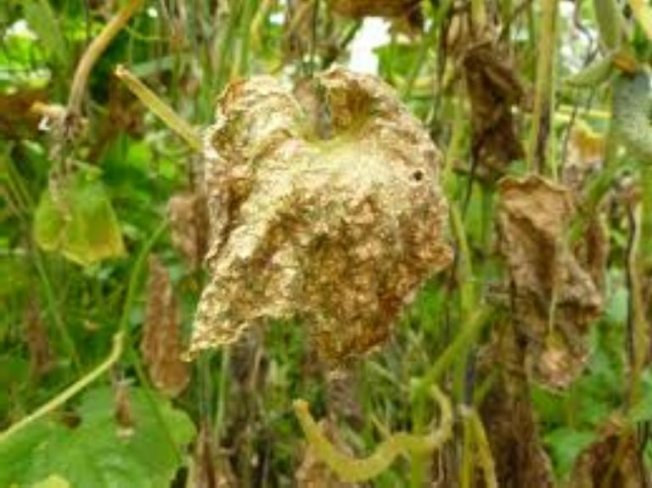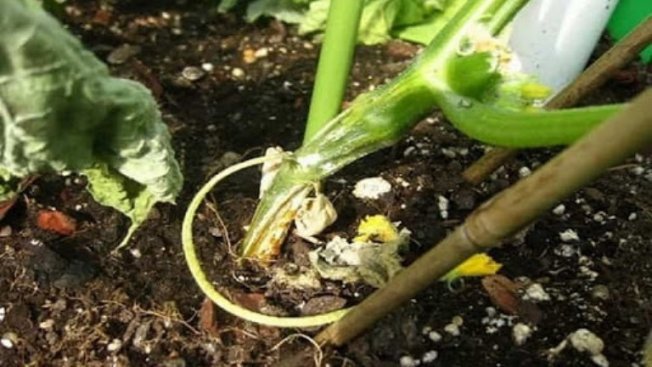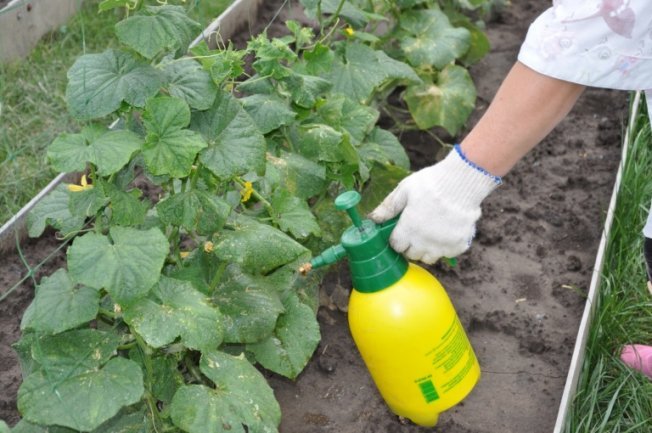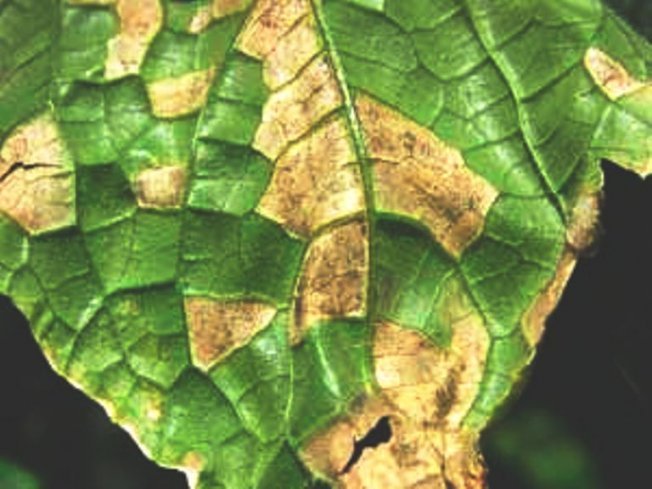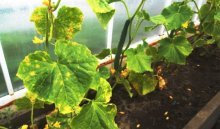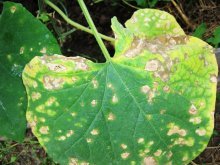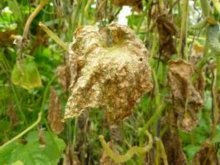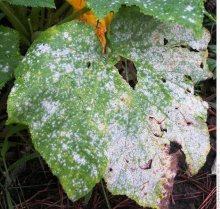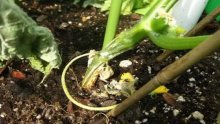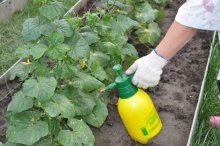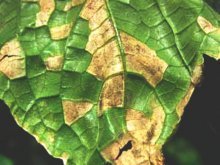Downy mildew of cucumbers in a greenhouse and their treatment, photos and symptoms of affected leaves, preventive measures
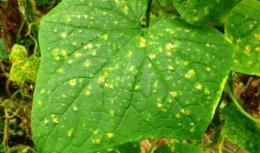
Downy mildew, or peronosporosis, is a fairly common disease of cucumbers in the greenhouse. It is important for novice gardeners to study in advance what its symptoms look like in the photo, because this will help identify diseased bushes and promptly treat them.
Content:
- Downy mildew, description of the disease, what it looks like in the photo
- What symptoms can you use to recognize downy mildew?
- How the disease develops
- Causes provoking the development of the disease
- What does downy mildew cause?
- Treatment
- Folk remedies against downy mildew
- Prevention
Downy mildew, description of the disease, what it looks like in the photo
Belle, or powdery mildew, is a disease caused by ectoparasitic microscopic fungi. They belong to the powdery mildew family. The development of mycelium occurs on the above-ground parts of plants: leaves, shoots, fruits. The cause of mycotic disease of cucumbers with very similar manifestations (downy mildew) are representatives of the family Peronosporonaceae, or more precisely, fungal-like oomycetes.
If you look at a diseased plant in the photo, it is not difficult to note the main distinguishing features of damage to peronospirosis: spots on the leaves of irregular shape and a change in the color of the leaves themselves, and browning of the leaves sometimes begins only in the last stages of the disease.
In most cases, infection is transmitted by air, with foliage being the primary target.
The development of pathogenic microorganisms disrupts the processes of photosynthesis, the growth and development of the plant is inhibited. Then the pathogenic pseudofungi move to neighboring plants.
Downy mildew of cucumbers in a greenhouse is dangerous because it spreads with lightning speed; only timely treatment will help preserve the plants, and it is recommended to start it as soon as you can recognize the symptoms of the disease. That is why it is recommended to carefully examine photos of affected bushes.
What symptoms can you use to recognize downy mildew?
Experienced gardeners are well aware of what cucumbers affected by peronosporosis look like. Their leaves are dotted with irregularly shaped spots. On the underside you can notice a whitish-lilac or grayish coating.
After some time, the leaf becomes deformed and the skin on the stems cracks. The leaves on which the stains have reached the central veins fall off. Compared to the healthy parts of the plant, the affected ones look more faded and limp.
As the disease develops, the shade of the foliage changes to brown, then it dries out and falls off. Affected ovaries and flowers darken and change shape. First of all, the young lashes of the bush die, then the plant completely stops developing.
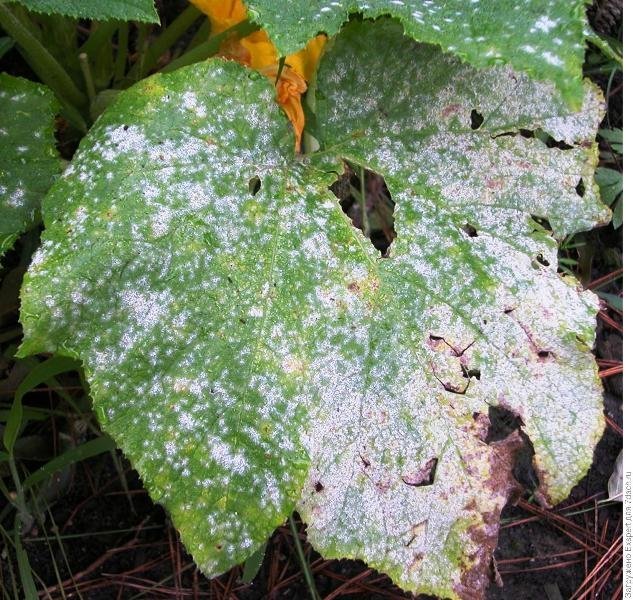
Another disease of cucumbers, black spot, has similar symptoms, but it affects the foliage from bottom to top; leaves fall off within a few days.
More detailed information about peronosporosis of cucumbers in the greenhouse and their treatment, photos of diseased leaves, watch the video:
How the disease develops
Although downy mildew has a rapid course, it can be divided into several stages, they occur in the following sequence:
- light yellowish spots appear on the outer surface of the sheets;
- the color of the affected area changes to yellow-green, oiliness appears;
- the outer part of the leaf acquires a brown tint, the inner part becomes covered with plaque;
- the affected areas grow and merge;
- leaves die;
- complete death of the plant occurs.
Cucumbers grown in greenhouses are more susceptible to downy mildew.
Symptoms of damage to plants grown in greenhouses and those grown in open ground may differ, for example: in the open air, the damage may look like small spots on the leaves.
Let's watch a useful video about that. how the disease develops and methods of combating it:
Causes provoking the development of the disease
Downy mildew can affect not only cucumbers, but also zucchini and melons. The active development of fungus-like parasites begins when they enter a humid, warm environment.
A positive point: the dry and hot climate in some regions allows you to avoid serious crop losses, even if cucumbers are affected by downy mildew.
As the main provoking factors, we note:
- high humidity resulting from excessive watering or frequent rains;
- use for cold water irrigation;
- growing in greenhouse conditions with insufficient ventilation;
- Condensation constantly settling on the walls of the greenhouse;
- dense plantings;
- poor ventilation of beds;
- frequent dew, foggy weather;
- a large number of weeds in the beds.
Downy mildew is extremely rarely observed in dry weather. But when favorable conditions arise, infection and death of plants can occur in a very short time.
Often, the defeat of cucumbers by downy mildew is complemented by bacteriosis: pathogenic oomycetes create favorable conditions for the development of another disease.
With double damage, the plants have a sick appearance, their leaves are covered with yellow-brown spots dusted with white, flour-like pollen.
What does downy mildew cause?
The development of pathogenic false fungi leads to the following negative results:
- disruption of the photosynthesis process, which causes plants to suffer from a lack of nutrients;
- changing the shape of the fruit to irregular;
- crushing of fruits and deterioration of their taste;
- possible complete absence of ovaries;
- yellowing and dying of leaves, which, falling on the ground, infect the entire area.
Today there is no reliable information about whether seeds taken from cucumbers grown on diseased plants are the source of infection.
Treatment
Downy mildew of cucumbers in a greenhouse and their treatment require a careful approach, so we will provide a description and photo of effective means to combat the disease.
The spread of the disease can be stopped by using modern means for pollination and spraying of bushes.
You can provide first aid to the plant as follows:
- stop watering and fertilizing;
- spray the bushes with copper oxychloride, Bordeaux mixture, polycarbacine, recommended solution temperature is +25 C;
Treatment with 0.5% solutions of the following drugs gives a good effect: Ridomil Gold, Cabrio Duo, Kurzat, Ordan. It is very important that during the treatment period the temperature in the greenhouse is maintained at about +25 C.
When growing cucumbers outdoors, it is recommended to cover them with film at night.
Folk remedies against downy mildew
Those. Those who do not want to treat the beds with chemicals can use folk recipes, we indicate them in the table.
| Composition of the product | How to prepare the solution | Frequency of treatments |
| Soda 25g, liquid soap 15g, hot water 5l | Mix everything thoroughly, after cooling, spray on the plant and on the top layer of soil underneath it. | Treatments at least 2, with a break of 7 days |
| Onion peel, 250-350g, water 10l | Add onion peels to a bucket of hot water, bring to a boil, leave for 2-3 days, and strain. | 2-3 treatments will be required, with a break of a week |
| Iodine 5% 10 drops, skimmed cow's milk 1l, water 9l | Bushes are sprayed | Apply 2-3 times with an interval of 7-10 days |
| Wood ash 2 cups, 2-3 liters of boiling water | Brew the ash like tea, strain, dilute with 10 liters of water | The treatment is repeated several times a season. |
Let us remind you that it is recommended to tear off infected leaves and burn them; such actions will help stop the spread of the disease to neighboring bushes.
Preventive measures
It is easier to prevent any disease than to treat it; peronosporosis of cucumbers in a greenhouse is no exception. Proper use of preventive measures gives a chance to assume that the problem may not arise at all.
The most effective measures to prevent downy mildew:
- periodic spraying of plants with whey solution;
- disinfection of seeds with antifungal drugs;
- pruning and burning of affected leaves, fruits, shoots (fungal spores can overwinter in plant debris and resume their development with the onset of the new season);
- at stages III and IV of damage, the fight becomes useless; it is more rational to cut off the damaged parts of the plant and burn them.
The question naturally arises of how to water the soil in the beds in a greenhouse in order to prevent downy mildew on cucumbers. Experienced vegetable growers use watering the soil with hot water and then covering the beds with film.
An important point is the replacement of the top 7 centimeter layer of soil in a greenhouse or greenhouse; this should be done every 3-4 years.
To disinfect the soil and all structural elements, you can use a 1% solution of copper sulfate.
Knowledge about the nature of the common disease will help prevent downy mildew of cucumbers in a greenhouse and simplify their treatment; studying photos of affected leaves will help you learn to identify the symptoms of the disease at its earliest stages, when you can still save the crop.

